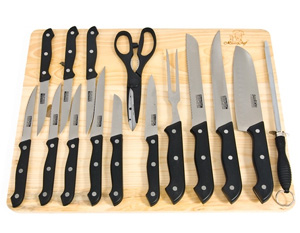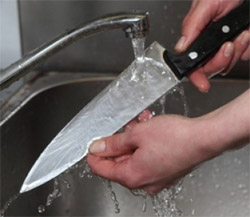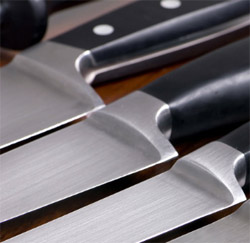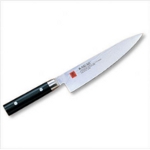Tips for Choosing Kitchen Knives

So you’re in charge of your own kitchen now and you need to build up your collection of kitchen tools. As any professional or aspiring chef knows, the greatest tools you have at your disposal are knives. Different knives perform different functions, of course, be it chopping, mincing, dicing, slicing, paring, scooping, sawing, or deboning.
With knives, you generally get what you pay for. There are plenty of decent knives out there for reasonable prices. For better quality performance, however, you should expect to shell out more money. Before you make any expensive purchases you need to decide exactly what you need and how much you’re willing to pay for it.
Do you need a whole set?
One of the first decisions you should make is whether to look for one really good open stock knife or a complete knife set. Often this choice boils down to your budget. Knife sets can be really economical if you find a decent set for a fair price. But you may also just want a good chefs knife or a basic utility knife. Perhaps you already have a knife set but a piece or two broke or went missing, and you really just want to replace those.
While a fine-quality chefs or santoku knife can serve you well in the kitchen, handling most of the basic cutting tasks, it can also be quite expensive—sometimes more expensive than a basic knife set that offers a bit of everything: paring, bread, utility, and steak knives. Sets typically come with a sharpening steel so you can keep the edges fine and sharp. Another benefit of the knife set is the convenient knife block that stores and protects your knives and looks so fancy on the counter.
Regular or professional quality
It’s perhaps unfair to compare regular kitchen knives to professional knives, because the knives you find in most kitchens are perfectly adequate for the tasks they’re assigned. Professionals look for knife sets with extra fine edges and ceramic blades. These knives are top-quality, but they also require a lot of maintenance—more maintenance than they’re worth if you’re just a regular person looking for regular kitchen knives. Regular knives, while still great quality, are much easier to upkeep. The stainless steel kind hold up well, don’t stain or rust with proper care, and sharpen easily.
Picking the best knives
Sometimes what qualifies as the best in knives comes down to personal preference. Some people like a heavy, sturdy feel. Forged stainless steel blades with bolsters fit big hands well and feel powerful. Other people prefer a lighter feel, a bit more flexibility. Stamped blades tend to be a little lighter and easier to handle.
Handle material also comes into play.
- Wooden handles are attractive and traditional, but if they’re left in water too long they can crack or warp. Bacteria also likes to hide in the wood’s porous surface.
- Plastic handles are usually of some cushioned, non-slip material. They’re hygienic and look fine if you like a contemporary style.
- Some knife handles use a composite of wood and plastic, providing the heft and aesthetic appeal of one and the sanitary features of the other.
Ultimately, you’re the best judge when it comes to determining what works for you. Shop around, read reviews, and compare prices before making your final purchase. Whenever possible, go to a store and handle different knives yourself to get a feel for the weight, balance, and style you prefer.
 |
Brittany Rowland researches new developments in Appliances, Kitchen and CE products features with a vigor to which few would aspire… but someone has to do it. See more about Brittany |
Related Knife Set Articles
How to Wash Your Knives

After a lot of busy work in the kitchen, chopping up and cooking food, you just want to enjoy the fine meal you’ve prepared and get the kitchen cleaned as quickly as possible. It’s tempting to throw your nice knives in the dishwasher along with all the other cookware, but you should resist the urge… [more]
The Importance of Chefs Knives

When it comes to preparing food, the knife is of utmost importance. For the greatest control and versatility, a chefs knife cannot be topped. Featuring a blade between 8 and 10 inches long, it’s expensive and requires special care… [more]
The Essential Knives You’ll Find in Most Knife Sets

Knife sets vary in the types of knives they offer. Typically, the more knives in a set, the higher the price rises. While it’s awfully convenient to have a versatile collection for all your cooking tasks, you also don’t want to get saddled with a bunch of frilly knives that you never use… [more]
Related Top 10 Lists
Top 10 Chef’s Knives

The finest quality chefs knives are guaranteed to last you many years and provide versatile function in the kitchen. We looked for a variety of factors as we selected our top 10 knives, including: Durable, strong forged steel… [more]
Top 10 Santoku Knives

The finest quality santoku knives are guaranteed to last you many years and provide versatile function in the kitchen. The word santoku means “three virtues,” after all. We looked for a variety of factors as we selected… [more]
Top 10 Knife Sets

Knife sets can be a convenient solution if you want a complete set of all the essential tools but you don’t want to spend a fortune on each individual knife. Value was one of the key considerations…[more]
Filed Under: Chef's Knives • Kitchen • Knife Sets • Santoku Knives

















